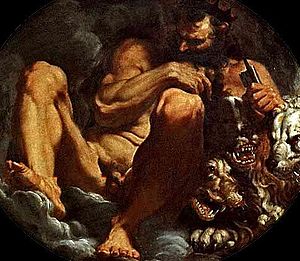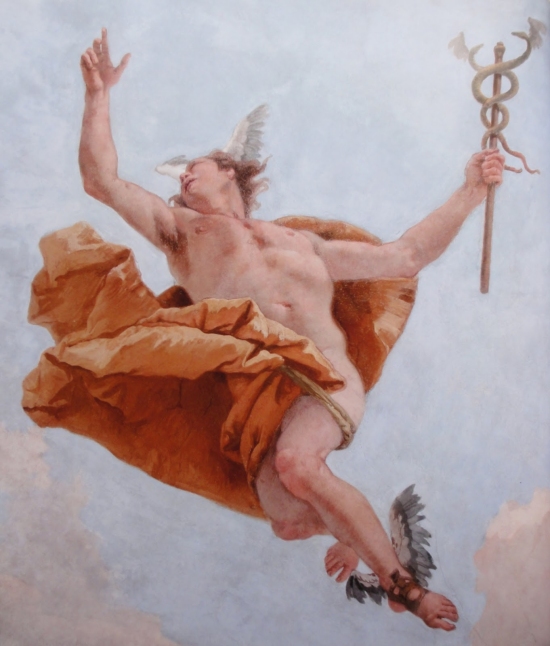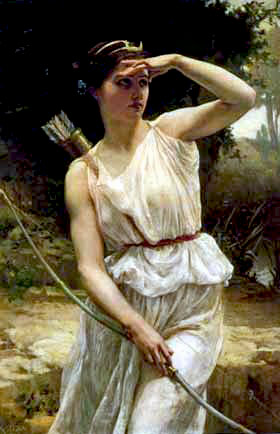 Studio Tablinum: cari lettori con questo articolo siamo giunti alla conclusione del nostro ciclo sulla mitologia greca. Quest’ultimo articolo l’ho riserbato ad una divinità benefattrice, come il povero e sfortunato Dio Efesto, ricorderete, il Dio costruttore dell’Olimpo. Bene questo mese tratteremo le vicende della Dea della Natura, Demetra.
Studio Tablinum: cari lettori con questo articolo siamo giunti alla conclusione del nostro ciclo sulla mitologia greca. Quest’ultimo articolo l’ho riserbato ad una divinità benefattrice, come il povero e sfortunato Dio Efesto, ricorderete, il Dio costruttore dell’Olimpo. Bene questo mese tratteremo le vicende della Dea della Natura, Demetra.
Demetra è figlia dei Titani Crono e Rea, sorella di Zeus, ed è la Dea dell’Abbondanza, dell’Agricoltura e della Terra, definita anche la Madre Terra. Demetra era l’artefice del ciclo delle stagioni e della vita e della morte.
Quindi una Dea, il più delle volte, che portava all’umanità ricchezza e benessere, potremmo quindi definirla una Dea “costruttiva”. Il dono più grande che Demetra fece all’umanità furono i cereali * che consentirono a questi di elevarsi a uno status superiore e di distinguersi dagli animali selvatici.
 Demetra donò agli uomini anche la conoscenza delle tecniche agricole: la semina, l’aratura, e la mietitura. La Dea Demetra provava un grande amore che era la piccola figlia Persefone, avuta con il Padre degli Dei. E questa è la vicissitudine che rischiò di portare all’estinzione il genere umano. Ecco perché: il Dio dei Morti, Ade, il fratello oscuro e ombroso di Zeus, stanco della solitudine del sua reggia infernale, sempre solo con le anime dannate, decise che forse non era giusto che a lui fosse precluso avere una moglie. Chiese di essere ricevuto dal Padre degli Dei, che pur disprezzandolo, decise di acconsentire a fin che lui prendesse moglie, anche Zeus sapeva di cosa era capace il terribile fratello e per evitare guai peggiori lo accontentò. Tuttavia era altamente improbabile che potesse trovare una sposa che decidesse di sua spontanea volontà di seguirlo nel regno delle ombre e della desolazione e quindi decise di passare alle vie di fatto, con la forza, ossia con un rapimento.
Demetra donò agli uomini anche la conoscenza delle tecniche agricole: la semina, l’aratura, e la mietitura. La Dea Demetra provava un grande amore che era la piccola figlia Persefone, avuta con il Padre degli Dei. E questa è la vicissitudine che rischiò di portare all’estinzione il genere umano. Ecco perché: il Dio dei Morti, Ade, il fratello oscuro e ombroso di Zeus, stanco della solitudine del sua reggia infernale, sempre solo con le anime dannate, decise che forse non era giusto che a lui fosse precluso avere una moglie. Chiese di essere ricevuto dal Padre degli Dei, che pur disprezzandolo, decise di acconsentire a fin che lui prendesse moglie, anche Zeus sapeva di cosa era capace il terribile fratello e per evitare guai peggiori lo accontentò. Tuttavia era altamente improbabile che potesse trovare una sposa che decidesse di sua spontanea volontà di seguirlo nel regno delle ombre e della desolazione e quindi decise di passare alle vie di fatto, con la forza, ossia con un rapimento.
 La triste decisione cadde sulla giovane figlia di Zeus, Persefone, avuta appunto con la Dea Demetra, che in quel momento, sola e ignara di quanto stava per accadergli giocava spensierata in un prato erboso e ricco di narcisi, nel cuore della Sicilia. Tutto d’un tratto la terra inizio a tremare in modo violentissimo** e la piccola Persefone cadde a terrà terrorizzata. Dalle oscure cavità della terra emerse il Dio dei Morti Ade, sul suo cocchio trainato da destrieri che sbuffavano fuoco, e in men che non si dica rapì Persefone con destrezza ritornando nell’antro da cui era sbucato.
La triste decisione cadde sulla giovane figlia di Zeus, Persefone, avuta appunto con la Dea Demetra, che in quel momento, sola e ignara di quanto stava per accadergli giocava spensierata in un prato erboso e ricco di narcisi, nel cuore della Sicilia. Tutto d’un tratto la terra inizio a tremare in modo violentissimo** e la piccola Persefone cadde a terrà terrorizzata. Dalle oscure cavità della terra emerse il Dio dei Morti Ade, sul suo cocchio trainato da destrieri che sbuffavano fuoco, e in men che non si dica rapì Persefone con destrezza ritornando nell’antro da cui era sbucato.
Accortasi della sparizione della figlia Demetra sprofondo in un dolore indescrivibile. Inizio ad interrogare tutti gli uomini e animali del creato, purtroppo senza risultato, in verità nessuno voleva inimicarsi il Dio dei Morti, quindi non volevano saperne nulla di quella vicenda.
 Il decimo giorno la Dea lunare Ecate, mossa a compassione, decise di svelare l’accaduto a Demetra e insieme si recarono dal Dio del Sole Apollo, che tutto vede e tutto sa. Anche Apollo confermo la versione di Ecate e informo Demetra del patto segreto fra Zeus e Ade, affinché quest’ultimo scegliesse la propria sposa. Adiratasi e chiusa nel suo dolore decise di abbandonare l’Olimpo e vagare per terre lontane alla ricerca della figlia, camuffata da vecchia donna, ma prima prese una decisione drastica, essendo lei la Dea della Natura, decise di fermare questo ciclo vitale e che tutti soffrissero come stava soffrendo lei, quindi niente più raccolti, niente più fioriture e niente più stagioni.
Il decimo giorno la Dea lunare Ecate, mossa a compassione, decise di svelare l’accaduto a Demetra e insieme si recarono dal Dio del Sole Apollo, che tutto vede e tutto sa. Anche Apollo confermo la versione di Ecate e informo Demetra del patto segreto fra Zeus e Ade, affinché quest’ultimo scegliesse la propria sposa. Adiratasi e chiusa nel suo dolore decise di abbandonare l’Olimpo e vagare per terre lontane alla ricerca della figlia, camuffata da vecchia donna, ma prima prese una decisione drastica, essendo lei la Dea della Natura, decise di fermare questo ciclo vitale e che tutti soffrissero come stava soffrendo lei, quindi niente più raccolti, niente più fioriture e niente più stagioni.
Gli Olimpi accusarono, come gli uomini, questa decisione, vedendo le offerte in loro suffragio diminuire drasticamente e sentendo più imprecazioni che preghiere, si rivolsero all’unisono al Padre degli Dei perché facesse terminare questa carestia voluta da Demetra.
Zeus acconsenti affinché ritornasse l’abbondanza sulla terra e indirettamente sull’Olimpo, mandò quindi la Dea Iris a cercare Demetra e convincerla a riprendere il suo posto nell’ordine cosmico.
 E qui le vicende della Dea Demetra si intrecciano con Eleusi. Si deve infatti alla Dea Demetra la creazione dei Misteri Eleusini, che hanno aiutato l’essere umano a comprendere meglio se stesso e tutto quello che gli sta attorno.
E qui le vicende della Dea Demetra si intrecciano con Eleusi. Si deve infatti alla Dea Demetra la creazione dei Misteri Eleusini, che hanno aiutato l’essere umano a comprendere meglio se stesso e tutto quello che gli sta attorno.
Questi misteri hanno a che vedere con la perdita dell’amata figlia Persefone. Durante uno dei suoi pellegrinaggi si fermò presso un albero, nei pressi della città di Eleusi, e si mise a piangere sconsolata per non poter più rivedere il volto della giovane figlia. La trovarono le figlie del re di Eleusi, Celeo, che decisero, mosse a compassione, di ospitare la vecchia donna presso la loro corte.
 Demetra, nelle vesti di vecchia balia, si dette subito da fare accudendo il giovane figlio del re di Eleusi, entrando in simbiosi con la regina Metanira, che forse si accorse che quella donna era qualcosa di più di una povera vecchia, a tal punto da affidargli il loro unico figlio maschio, Demofonte. Per alleviare la tristezza della vecchia donna Metanira decise di affidargli la sua ancella più irriverente e sbarazzina, la giovane Iambe*** che con scherzi e oscenità di ogni genere riuscì a strappare un sorriso divertito alla Dea della Natura. In questo la serva riuscì dove tutti gli altri Dei avevano fallito.
Demetra, nelle vesti di vecchia balia, si dette subito da fare accudendo il giovane figlio del re di Eleusi, entrando in simbiosi con la regina Metanira, che forse si accorse che quella donna era qualcosa di più di una povera vecchia, a tal punto da affidargli il loro unico figlio maschio, Demofonte. Per alleviare la tristezza della vecchia donna Metanira decise di affidargli la sua ancella più irriverente e sbarazzina, la giovane Iambe*** che con scherzi e oscenità di ogni genere riuscì a strappare un sorriso divertito alla Dea della Natura. In questo la serva riuscì dove tutti gli altri Dei avevano fallito.
Demetra per ringraziare la regina Metanira di tanta benevolenza decise di rendere il piccolo Demofonte immortale e inizio la sua pratica misterica nel cuore della notte. Metanira, che aveva capito che quella vecchia donna era molto più di quello che voleva far capire, decise di spiarla e con sorpresa e terrore scopri il piccolo Demofonte in preda a questi rituali e interrompendo la danza mistica di Demetra, inizio a urlare e inveire contro di essa.
 Demetra a quel punto andò su tutte le furie dicendo alla regina che il rito avrebbe reso il suo unico figlio maschio immortale, un dono incommensurabile.
Demetra a quel punto andò su tutte le furie dicendo alla regina che il rito avrebbe reso il suo unico figlio maschio immortale, un dono incommensurabile.
Nel mentre pronunciava queste parole Demetra riprese le sue forme divine, terrorizzando ancora di più la regina Metanira, e andandosene ordinando alla regina la costruzione di un tempio in suo onore dove venissero praticati, ogni anno, i riti che Demetra insegnerà agli iniziati.
Dopo una lunga ricerca la Dea Iris trovò la Dea della Natura, poco fuori da Eleusi e riferì il messaggio di Zeus, ossia di ritornare e riappacificarsi con gli Olimpi. Demetra rifiuto seccamente, dicendo ad Iris di riferire al Padre degli Dei che non sarebbe mai più tornata se non gli fosse stata restituita la sua figliola Persefone.
 Trovandosi a mal partito Zeus accetto e intimo al fratello Ade la restituzione di Persefone, a quel punto già divenuta sua sposa e regina degl’inferi. Ma Ade ideo uno stratagemma; acconsenti a finché Persefone potesse ritornare fra le braccia della madre, ma prima che partisse dalla reggia oscura diede alla piccola Persefone un frutto, che la piccola mangio.
Trovandosi a mal partito Zeus accetto e intimo al fratello Ade la restituzione di Persefone, a quel punto già divenuta sua sposa e regina degl’inferi. Ma Ade ideo uno stratagemma; acconsenti a finché Persefone potesse ritornare fra le braccia della madre, ma prima che partisse dalla reggia oscura diede alla piccola Persefone un frutto, che la piccola mangio.
Era il frutto dei morti: il melograno. Un frutto dai semi rossi come il sangue. Con questo frutto Ade vincolo a se Persefone per l’eternità.
 Tornata che fu in superficie Persefone si getto fra le braccia di Demetra, che in quel momento tornava a nuova vita. Mantenendo la promessa, con un solo gesto della mano, la Dea della Natura fece riprendere il ciclo delle stagioni e in un attimo i campi erano colmi di spighe di grano e gli alberi carichi di frutti.
Tornata che fu in superficie Persefone si getto fra le braccia di Demetra, che in quel momento tornava a nuova vita. Mantenendo la promessa, con un solo gesto della mano, la Dea della Natura fece riprendere il ciclo delle stagioni e in un attimo i campi erano colmi di spighe di grano e gli alberi carichi di frutti.
Cera però qualcosa che non tornava a Demetra e conoscendo l’infida natura del Dio dei Morti domando alla piccola Persefone se avesse toccato qualcosa o mangiato qualcosa nel regno dei morti. La piccola Persefone confermo le paure della madre, dicendole che aveva accettato il melograno. A quel punto Demetra capi dove stava l’inganno e dovette, dolorosamente, accettare quelle condizioni e dire a Persefone che avrebbe dovuto tornare nel regno dei morti, come regina, per i sei mesi invernali, mentre per i restati sei, quelli estivi, sarebbero state insieme.
 Comprendiamo da questa vicenda la gioia e il dolore di Demetra, da un lato avrebbe voluto sua figlia tutta per se, dall’altro era meglio averla per soli sei mesi, che non rivederla mai più.
Comprendiamo da questa vicenda la gioia e il dolore di Demetra, da un lato avrebbe voluto sua figlia tutta per se, dall’altro era meglio averla per soli sei mesi, che non rivederla mai più.
In fondo da questa vicenda nacque il percorso iniziatico che tutte le giovani greche doveva intraprendere, dalla condizione di vergini alla condizione di spose. Percorso che simbolicamente rappresentava la morte**** della fanciullezza e la nascita dell’età adulta.
Demetra fu una divinità che non fece scalpore fra gli Olimpi, sempre ligia al dovere, aveva il delicato compito di mantenere un equilibrio fra tutte le cose create, la Natura in un qualche modo gli competeva direttamente.
Possiamo tuttavia trovare una vicenda di “gossip” legata al tentativo di seduzione da parte del Dio del Mare Poseidone.
 Demetra accortasi delle avance di Poseidone decise di trasformarsi in una cavalla e confondersi nella mandria di cavalli del re Onkios, della città di Onkeion, ma il Dio Azzurro non si fece ingannare e scovata la “cavalla” a cui era interessato, anch’esso si trasformo in cavallo, uno splendido stallone e si accoppio con la Dea Demetra. La Dea della Natura fu letteralmente furibonda e andò a lavare quella sozzura nel fiume Ladona. Tuttavia da quella unione forzata nacque una figlia, il cui nome era proibito pronunciare al di fuori dei Misteri Eleusini, e un cavallo dalla folta criniera, nero come la pece, Arione. Arione che fu donato dal re Onkios all’eroe Eracle per la spedizione contro la città di Elide.
Demetra accortasi delle avance di Poseidone decise di trasformarsi in una cavalla e confondersi nella mandria di cavalli del re Onkios, della città di Onkeion, ma il Dio Azzurro non si fece ingannare e scovata la “cavalla” a cui era interessato, anch’esso si trasformo in cavallo, uno splendido stallone e si accoppio con la Dea Demetra. La Dea della Natura fu letteralmente furibonda e andò a lavare quella sozzura nel fiume Ladona. Tuttavia da quella unione forzata nacque una figlia, il cui nome era proibito pronunciare al di fuori dei Misteri Eleusini, e un cavallo dalla folta criniera, nero come la pece, Arione. Arione che fu donato dal re Onkios all’eroe Eracle per la spedizione contro la città di Elide.
 In questa vicenda vediamo il lato violento della Dea della Natura. Il re di Tessaglia Erisittone, nella sua tracotanza e superbia, volle abbattere deliberatamente un bosco sacro alla Dea Demetra. Il motivo era del tutto futile, con quel legname voleva costruirsi una sala da pranzo. La Dea della Natura andò su tutte le furie e punì la sua empietà condannandolo alla fame eterna. Da quel giorno Erisittone non riuscì più a saziarsi, spinto dalla continua bramosia di cibo, il re di Tessaglia finì per dilapidare il tesoro reale e fu costretto a mettere in vendita la propria figlia, più volte, al mercato.
In questa vicenda vediamo il lato violento della Dea della Natura. Il re di Tessaglia Erisittone, nella sua tracotanza e superbia, volle abbattere deliberatamente un bosco sacro alla Dea Demetra. Il motivo era del tutto futile, con quel legname voleva costruirsi una sala da pranzo. La Dea della Natura andò su tutte le furie e punì la sua empietà condannandolo alla fame eterna. Da quel giorno Erisittone non riuscì più a saziarsi, spinto dalla continua bramosia di cibo, il re di Tessaglia finì per dilapidare il tesoro reale e fu costretto a mettere in vendita la propria figlia, più volte, al mercato.
Ebbene la figlia di Erisittone, Mestra, era l’amante del Dio del Mare Poseidone ed ebbe dal Dio Azzurro il dono delle metamorfosi, il che le consentiva di mutarsi in qualsiasi animale lei volesse. Erisittone, conoscendo il dono di Mestra, la costrinse a divenire un animale diverso ogni giorno, per poi essere venduta al mercato e scappare nottetempo, per far ritorno alla reggia. Il tutto si ripeteva ogni giorno…
Ma anche questo non basto allo sventurato Erisittone, la sua bramosia di cibo cresceva ogni giorno e la Dea della Natura, decise di porre fine a questa situazione.
Costrinse Erisittone a divorare se stesso, per poter placare la sua fame insaziabile.
 Mentre la vicenda che vede la Dea Demetra amare qualcuno al pari della figlia Persefone è davvero degna di essere raccontata.
Mentre la vicenda che vede la Dea Demetra amare qualcuno al pari della figlia Persefone è davvero degna di essere raccontata.
Il figlio di Zeus e di Elettra, Iasione, viveva a Samotracia ed ebbe la fortuna di avere una relazione amorosa con la Dea della Natura, ricordiamo che la Dea Demetra, a suo tempo, ebbe da Zeus una sola figlia Persefone. Dalla notte d’amore che ebbe con Iasione ebbe un figlio maschio, dal nome Pluto, ossia la Ricchezza. Il loro giaciglio fu un campo di maggese “rivoltato” tre volte, protetti dalla natura.
Il loro piccolo Pluto inizio da subito a pellegrinare per la terra diffondendo dappertutto ricchezza e abbondanza, sfiorando con il suo tocco gli uomini più meritevoli.
I simboli della Dea Demetra erano: i papaveri, i narcisi e i fasci di grano che reggeva fra le mani, mentre i suoi animali sacri erano: la gru e la scrofa. I suoi luoghi di culto erano disseminati in tutta la Grecia: Eleusi, Delo, Corinto, Samotracia, Pergamo e nella Magna Grecia: Agrigento, Selinunte, Enna e Siracusa.
La Dea della Natura era particolarmente adorata nelle campagne, dove si conduceva una vita rurale, e dove si tramandava la conoscenza che la Dea stessa dono agli uomini. Molte offerte votive sono state rinvenute dagli archeologi esclusivamente in relazione al culto della Dea Demetra, come i porcellini di creta, realizzati nel Neolitico.
Le ninfe che si prendevano cura della Dea Demetra erano chiamate Melisse ed erano delle ninfe dei boschi, la più nota di queste, Melissa, accudì Zeus in fasce, insieme alla capra Amaltea, e aveva il compito di nutrire il futuro Padre degli Dei con il dolce Miele.
Alessandro Cerioli
* la parola cereale deriva dal latino Cerere, ossia l’equivalente romano della Dea Demetra.
**le leggende narrano che fu a causa di questo terremoto, provocato dal Dio Ade, che la Sicilia si stacco definitivamente dal resto della penisola italiana.
***Da Imabe derivo la famosa poesia comica, Iambos, ricca di elementi scherzosi e osceni, che sotto forma di stornelli veniva cantata in modo derisorio ad amici e nemici.
****Ancora oggi si parla dell’orgasmo come di una “piccola morte”. In se Persefone racchiude il mistero delle due condizioni. Con la madre Demetra appare come la vita, con lo sposo Ade appare come la morte.













































































